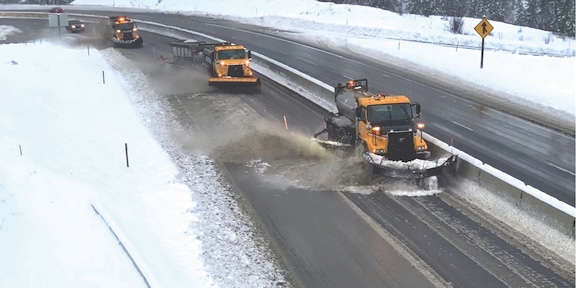ODOT laying off more than 30 workers in NE Oregon
Published 10:00 pm Sunday, July 13, 2025
Statewide, the Oregon Department of Transportation is laying off 483 workers, closing numerous shops
Almost three dozen employees from Northeastern Oregon are among the 483 Oregon Department of Transportation workers who were told last week they will be laid off by July 31 because the Oregon Legislature failed to pass a transportation spending bill during the session that ended in late June.
And 31 of those 35 workers are transportation maintenance specialist 2 positions, said Kacey Davey, an ODOT public information officer.
Those workers do a variety of tasks, including driving snowplows and maintaining highways, bridges and signs, according to an ODOT job description.
Trending
Unions represent about half of ODOT’s roughly 5,000 workers. The largest is the Service Employees International Union.
Davey said layoffs comply with union contracts, which are “designed to preserve the most senior employees.”
In addition, union workers who have a layoff notice “have the right to move into other positions, both vacant and filled, following specific processes. This means the impacts to specific regions, programs and services may not be fully known for several months.”
Davey said the layoffs will result in reduced maintenance on highways, including during winter.
“As winter approaches, the public can expect slower snow and ice removal, particularly in mountainous areas,” Davey wrote in an email to the Baker City Herald on July 8, the day after ODOT sent layoff notices. “Deicing treatments will be scaled back, increasing the risk of icy roads and dangerous driving conditions. We are committed to maintaining safety and essential services with the resources we have, but there will be fewer people, fewer services and less capacity to respond. Oregon’s travelers will soon experience a less reliable transportation system year-round.”
A transportation maintenance specialist 2 from Baker County who received a layoff notice on July 7, and who requested anonymity, said the layoffs, unless there’s a change, will have a major effect on travel through the Blue Mountains this winter.
Trending
“It’s going to be ugly,” the employee said.
In addition to effects on Interstate 84, the region’s main arterial which already closes several times each winter, secondary routes such as Highway 245 over Dooley Mountain, the steep, winding pass south of Baker City, could quickly become impassable during a blizzard without regular plowing, the employee said.
The employee said the loss of six maintenance specialists in Baker County amounts to 30% to 40% of the ODOT workforce in the county.
Jason Lawrence is vice president of ODOT Sublocal 730 within Service Employees International Union 503, one of the state’s most powerful labor organizations. He said the first reaction many union members had to the layoffs were frustration and disappointment.
“This was completely avoidable, right? The Legislature could have come together and found a compromise of a funding package,” he said. “It’s just a frustrating sense to us of a lack of leadership there in the Legislature.”
Now the reality of the layoffs are hitting.
“You’re looking at the numbers, and you’re seeing the names on the list … There’s just nothing that it can really prepare you for when you’re looking at 483, you know, families that are potentially losing their breadwinner,” Lawrence said.
Lawrence said he got his layoff notice July 7 and had seven days to decide to accept that or to try to bump somebody with less seniority. There could be a few rounds of bumping rights, he said, as the layoffs are not going to be finalized until the end of the month.
Lawrence also said there is no doubt Oregon’s coastal and rural communities are going to bear the brunt of the layoffs, and 18% or 19% of ODOT’s maintenance workers are on the cutlist. A small crew in rural Oregon already covers hundreds of highway lane miles, he said, and now that work will land on the shoulders of even smaller crews.
“I think we’re closing 12 or 13 shops statewide,” Lawrence said.
Lawmakers weigh in
Sen. Todd Nash, R-Enterprise, said the Legislature just didn’t come together on a funding package for ODOT it could support.
“I don’t want to see anybody laid off,” Nash said. “I want a transportation package that serves Oregon well, but we just never got there this last session.”
Nash said he still has hopes for funding from Congress and the Farm Bill and is asking Oregon U.S. Rep. Cliff Bentz, R-Ontraio, to “step in the gap and make sure it comes through.”
Rep. Mark Owens, R-Crane, said he was disappointed ODOT decided to start laying off employees, arguing it should have had the budget to maintain its staff at least through this year.
“There is plenty of money in the state budget to fund ODOT,” he said, “but budgets are priorities. Other priorities with our colleagues rose above this.”
He said he would not support passing ODOT’s budget until knowing if House Bill 2025, the state’s comprehensive transportation funding package, passed. It did not. Owens said it was not appropriate to tie the transportation department’s budget to the transportation package.
The layoffs will affect road maintenance projects in Eastern Oregon 100%, he said, and road safety will be a concern in the winter.
Rep. Greg Smith, R-Heppner, said ODOT’s cuts are going to hit his House District 57 harder than some other areas.
“Shutting down snow plows in Mitchell, Oregon, is not acceptable,” he said, adding “deprioritizing chip sealing is now a good use of the limited dollars we have available.”
He said ODOT needs to take a “get-back-to-basics approach.”
“The Oregon Department of Transportation needs to look at projects it planned or are in the works, prioritize them, determine which are essential versus which are nice to have,” Smith said.
And Gov. Tina Kotek and her supporters who wanted more housing in Oregon need to acknowledge they are part of what is causing this situation, he said. If the state is going to build so much housing, it also needs to invest in the infrastructure that goes with that housing, from more green spaces to more roads.
And ODOT also needs to prioritize maintenance, operations and emergency services.
How to pay for this still remains the big challenge. Owens said he thinks the Legislature will come together in the fall for a special session to address ODOT funding. He said the $354.3
million ODOT needs to maintain staffing through the next biennium is not that much in the grand scheme of Oregon’s budget.
He said he is hopeful the state figures out some gap funding in the next 15 days to keep layoffs from occurring and to give lawmakers time to figure out funding for the transportation department.
Smith said he is against using any of the $1.9 billion in the state’s “rainy day fund” to pay for ODOT. The state should rely on that fund for fighting wildfires, he said, or a catastrophic emergency.
Whatever funding package the state brings together, Smith said, needs to be direct and understandable.
“Oregonians want to know what they are going to be asked to pay for,” Smith said, “and the Legislature needs to present to Oregonians what the priorities are.”
No solution is going to please everyone, he said.
“You just have to have the wherewithal to do it,” Smith said, “and those groups that push back you have to explain to them this is their fair share.”
Layoffs by the numbersThe largest number of Oregon Department of Transportation layoff notices – 159 statewide — went to transportation maintenance specialists. Salaries for transportation maintenance specialist 2 range from $50,436 to $74,940, depending on the union contract and length of employment. ODOT also plans to close maintenance stations in Mitchell and Condon, among the dozen statewide slated for closure. In addition to laying off workers, ODOT canceled three chip-sealing projects scheduled to start July 7 in Northeastern Oregon. Those were planned for sections of Highway 26 in Grant County, and Highways 203-A and 237-A in Union County. Davey said ODOT employees, not contractors, were going to handle those projects. Layoff notice totals elsewhere in ODOT’s Region 5, which includes these counties: Morrow, Umatilla, Wheeler, Grant, Wallowa, Union, Baker, Malheur and Harney. Umatilla County: 12 11 transportation maintenance specialist 2 1 office specialist 2 Union County: 10 1 construction project manager 2 1 environmental program manager 2 1 information systems specialist 6 7 transportation maintenance specialist 2 Wallowa County: 1 1 transportation maintenance specialist 2 Grant County: 4 4 transportation maintenance specialist 2 Malheur County: 7 7 transportation maintenance specialist 2 Morrow County: 2 2 transportation maintenance specialist 2 Wheeler County: 11 2 transportation maintenance coordinator 9 transportation maintenance specialist 2 Harney County: 4 1 heavy equipment technician 2 1 transportation maintenance specialist 1 2 transportation maintenance specialist 2 Elsewhere in Oregon The layoff list includes 160 employees in Marion County, where ODOT has its headquarters. Most are positions other than maintenance specialists. The list includes: • 48 information systems specialists • 26 operations and policy analysts • 9 administrative specialists • 8 engineering specialists • 5 program analysts • 3 procurement and contract specialists • 3 human resource analysts • 4 fiscal analysts • 4 executive support specialists • 2 public affairs specialists • 2 research analysts A total of 59 ODOT employees are slated to lose their jobs in Multnomah County, which is the most populous of Oregon’s 36 counties but the smallest in size, at 435 square miles. Baker County covers almost 3,100 square miles. Layoffs in Multnomah County include 14 transportation maintenance specialists, 12 engineering specialists and three professional engineers. |
— Eastern Oregon reporters Bill Bradshaw, Justin Davis and Berit Thorson and editor Phil Wright contributed to this report.










